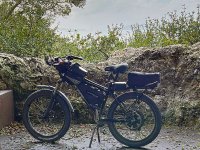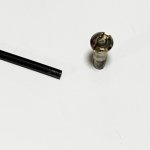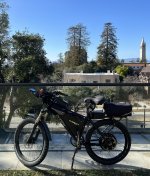I replaced the rear pads today, and saw that I needed to adjust the caliper mount a little more. There was a very small lip that wasn't contacting the rotor, and as the pad wore, the lip on both pads caused the pads to tilt, and wear more along the bottom until it was metal to metal. I adjusted the caliper adapter and seems like it should be good now. Stopping power seems improved.
The pads were the start of my winter maintenance. It's been raining for days, but I've been avoiding starting on the bike since it's cold out in the garage, which gave me a good excuse. Today, the sun came out, at least for a while, so I decided to change the pads. While changing them, I noticed I had a broken spoke. Ugh, my first ever, and immediately wondered if there would be more to come. I definitely need to get to the rear wheel redo, but after being cooped up in the house, I decided to take a quick ride while there was a break in the rain. I like looking at architecture, so I got the idea of Googling for something nearby and interesting. I ended up Googling the biggest mansion in Berkeley, and it spat out the
John Hopkins Spring Estate. I tried to view it on Google Maps but they have it blurred and the street view stops a block from the entrance.
This video made is look nice though. Posted 4 years ago, being offered at $7.5 million:
https://www.youtube.com/watch?v=CKcKWU8WTyk&t=483s
Then I saw this series of videos from 9 years ago, about a fundraiser to restore the mansion. It looked totally dilapidated, and nothing like the real estate video, so I assumed it had gone under renovation/restoration.
https://www.youtube.com/watch?v=rmvv1RweUUk
Well, I noticed when I got up there, I couldn't see it from the street below, so was hoping I could see it, driving past where Google Maps stopped. The street said
not a through street. It was actually a through street though, and the mansion was on the right about halfway through the "non through" part. The place was a mess and the landscaping was unkept. The concrete patio had big weeds growing up through the cracks. The structure itself looked like it needed a good power washing, patch repair and repainting. It looked like the "before" video from what I could see. There were several work trucks in the service entrance driveway, so I'm guessing that's what's going on. It explains the porta potty. Oh well, at least once it's really fixed up, I can say I saw the before state.

I decided to keep riding up the hill to see if there was anything else interesting. I'd ridden in the area before, but haven't gone on all of the streets. There are several rock climbing parks in the area. The hillside used to be all rock, and I've seen a few houses that have a boulder for their front yard, the size of my garage. So they made rock climbing parks where the bigger boulders are. Anyway, found a new one near the top of the hill that I hadn't ridden by before. It had a pretty cool lookout that looked over the bay and at the golden gate. The park has a short stone wall perimeter, and as you walk along it, you get a greater than 180 degree panoramic view of the bay, through openings in the foliage.

A few minutes after leaving the park, I felt a few droplets. Big ones. I hadn't noticed, but the big rain clouds had come in and the sun was gone. The brake pads got a pretty good workout going down the hill. I took a straighter route down, braking all the way down one street with a 15% steady grade for a half mile and didn't detect much fade. The rest of the ride down was less steep so no brake issues. I throttled home after that and just beat the rain. With the broken spoke, the bike is overdue for maintenance, so I have to get off my lazy butt and get it done. I'm excited about the torque sensor though.






